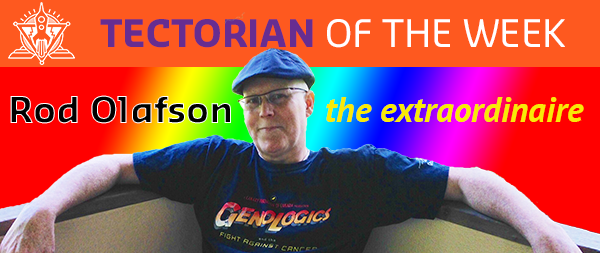Rod Olafson: AKA the extraordinaire or SDG (Software Development Guru / So Damn Good). Well, he may have never been called these, but we’re labelling him now. Enjoy the titles, Rod.
If a history book were written on the growth of Victoria’s technology sector, Rod would tag along in each chapter. He’s been in the midst of it all and seen now-giant software companies at their earliest stages. He’s also been involved with VIATEC when they helped transition his company, Magic Kite Software, to a federal corporation. All of this is why he’s our Tectorian of the Week!
HIS STORY
He was born in Vancouver and spent his young, formative years in Townsville, Australia until moving to Victoria when he was 16. Since then, he’s had a life of curiosity, excitement and adventures shaping his impressive career in our technology community and growing a beautiful family in Canada’s paradise.
While in Aussie land, Rod’s father worked for the Australian Institute of Marine Science (AIMS). This is where Rod had his first opportunity to play with computers – a mainframe machine owned by the Institute and accessed via paper-printing terminals. Old school when you think of it now, but at the time Rod was intrigued and it opened up a world of possibilities.
Before he even enrolled at university, Rod managed to get into the software community by writing a commercial product for UVic’s Biochemistry Department to track grant money. Pretty impressive for a guy fresh out of highschool!
Also before university, he scored an 8-year gig working for what is now the AXYS Group. While there, he wrote QUIKMap, which he believes to be one of the first ever graphical geographic information system on a microcomputer.
“At the time, there were no GUIs and everything had to be hand-coded: printer drivers, graphical drivers, digitizers, etc,” commented Rod. “You can’t imagine the effort it took to get to the point where you could focus on the product itself!”
Rod left AXYS in 1990 to enroll at the University of Victoria.
“With several years of development experience under my belt, my experience there was a little unusual. Object oriented design was in its infancy and I was both a convert and enthusiastic advocate. I had some great relationships with several of my profs.”
Amongst his professors was Bjorn Freeman-Benson, who was also deeply involved in the Object-Oriented (OO) movement. When Rod graduated from UVic with bright, hopeful eyes, Bjorn was running an office for Object Technology International (OTI) and hired Rod as the Development Team Lead. OTI’s focus was Smalltalk development and their clients were the likes of NASA, Mitsubishi, Honda, and Credit Suisse.
IBM eventually bought OTI and the various offices were slowly closed down. Rod had an opportunity to move to an IBM office elsewhere but chose to stay in Victoria, a decision that would be repeated throughout his career. There’s no place like home!
From OTI, Rod joined Voice Mobility as the Development Manager where him and his team of outstanding developers designed an amazing new telephony system from the ground up.
After Voice Mobility, Rod continued the Development Manager role in 2000, but this time with ACD Systems (now ACDSee), one of the largest and most respected independent digital image editing and management companies in the world.
“Rod was like a machine when it came to sticking to a process; he would not deviate!” described Colin How, past Director of Operations/Globalization of ACDSee. “Many times, as an ideas person, I had been frustrated by this. But now all these years later I finally get it. Rod gets s$#t done.”
Rod moved on to start Magic Kite Software with Ben Morris, another developer.
Their biggest contract was with Streetlight Technology, who had an amazing piece of hardware aimed at saving energy in streetlights around the world. Sourcerer was Magic Kite’s product, a system to manage software development projects.
“It was at this time that I became most involved with VIATEC, who helped us connect with business mentors and coached us through the process of creating a business plan and attracting investors,” commented Rod. “For a startup, run by a couple of software guys, VIATEC was invaluable.”
Next, Rod worked at CMaeON as Chief Technology Officer with CEO Tim Vasko for six years. They developed a system for rapidly building multi-tenant, low-bandwidth, web-based applications using a gadget-based framework. (Try saying that 3 times fast). in other words, the system they created has proven itself in finance, pharmacy, and real estate.
We’re almost to present day, but let’s flash back 13 years ago just for a moment…
Remember Rod’s father that worked at AIMS? Well, he became a biochemist at UVic and was approached by three students in 2002. The students wanted to build a Laboratory Information Management System (LIMS) for his protein sequencing lab.
“At the time, I was asked to review what they were planning to ensure everything was kosher,” reminisced Rod. “That project eventually turned into GenoLogics Life Sciences Software, one of Victoria’s most successful ventures.”
In an odd irony, Rod joined GenoLogics in 2013 as their Director of Software Development.
“They’re an amazing company, driven by a belief that a great internal culture will lead to a better product and organization – they’re absolutely right. I couldn’t be prouder of a company and, in joining them, I feel I’ve [finally] come home.”
GenoLogics was purchased in September 2015 by Illumina, the world’s leading provider of DNA sequencing equipment.
“I love what I do and, in that sense, there will always be a blur between work and home. That said, my proudest moments are definitely focused on family. I have two amazing 16 year old guys and a 9 year old daughter. Binding us all together is my wife, Jane, without whom nothing would be possible.”
Rod has stayed in Victoria throughout his career for selfish reasons. His family, of course, but also the vibrant software community.
“Victoria is chalk full of innovators – people excited to share their dreams and aspirations. It’s the community that makes this place great.”


Follow Us!